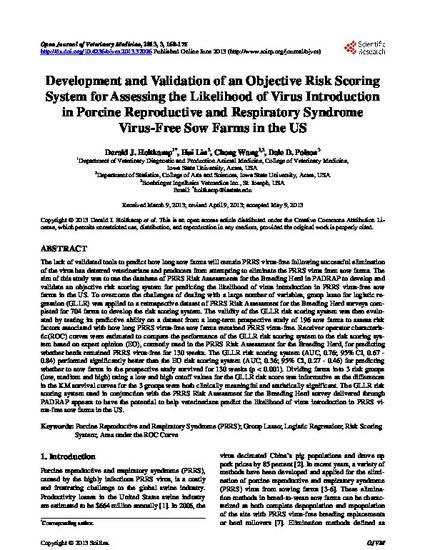
The lack of validated tools to predict how long sow farms will remain PRRS virus-free following successful elimination of the virus has deterred veterinarians and producers from attempting to eliminate the PRRS virus from sow farms. The aim of this study was to use the database of PRRS Risk Assessments for the Breeding Herd in PADRAP to develop and validate an objective risk scoring system for predicting the likelihood of virus introduction in PRRS virus-free sow farms in the US. To overcome the challenges of dealing with a large number of variables, group lasso for logistic re-gression (GLLR) was applied to a retrospective dataset of PRRS Risk Assessment for the Breeding Herd surveys com-pleted for 704 farms to develop the risk scoring system. The validity of the GLLR risk scoring system was then evalu-ated by testing its predictive ability on a dataset from a long-term prospective study of 196 sow farms to assess risk factors associated with how long PRRS virus-free sow farms remained PRRS virus-free. Receiver operator characteris-tic(ROC) curves were estimated to compare the performance of the GLLR risk scoring system to the risk scoring sys-tem based on expert opinion (EO), currently used in the PRRS Risk Assessment for the Breeding Herd, for predicting whether herds remained PRRS virus-free for 130 weeks. The GLLR risk scoring system (AUC, 0.76; 95% CI, 0.67 - 0.84) performed significantly better than the EO risk scoring system (AUC, 0.36; 95% CI, 0.27 - 0.46) for predicting whether to sow farms in the prospective study survived for 130 weeks (p < 0.001). Dividing farms into 3 risk groups (low, medium and high) using a low and high cutoff values for the GLLR risk score was informative as the differences in the KM survival curves for the 3 groups were both clinically meaningful and statistically significant. The GLLR risk scoring system used in conjunction with the PRRS Risk Assessment for the Breeding Herd survey delivered through PADRAP appears to have the potential to help veterinarians predict the likelihood of virus introduction in PRRS vi-rus-free sow farms in the US.
Available at: http://works.bepress.com/chong-wang/42/

This article is from Open Journal of Veterinary Medicine 3 (2013); 168, doi: 10.4236/ojvm.2013.32026. Posted with permission.